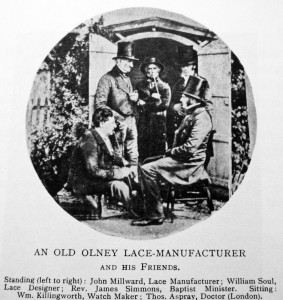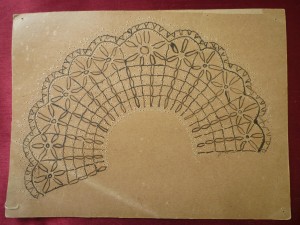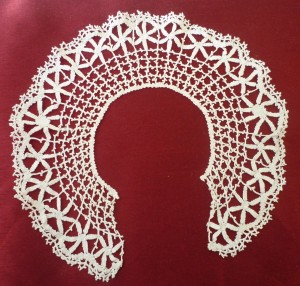Begin on the Market Place by the War Memorial facing south towards the Cowper and Newton Museum
Continental lacemakers came to this area of North Buckinghamshire as a result of religious persecution in their own countries from the late 1500s through to the late 1600s. The lacemakers, particularly those from Lille and Mechlin, settled here in the small market town of Olney and taught the local women to make bobbin lace and thus began a cottage industry which lasted for over 300 years.
The equipment for lacemaking could be made locally – the straw stuffed pillow, the wooden ‘horse’ or ‘maid’ to support the pillow, the parchment patterns, and of course the wooden and bone bobbins, examples of which you can see in the Cowper and Newton Museum.
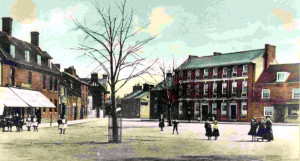
Olney Market Place South-East, c.1900
The lacemakers lived in small cottages in the many ‘courts’, off the High Street, Market Place and in Silver End (the street to the left of the Museum building).
The one lacemaking commodity which could not be produced locally was the thread, linen originally, and later cotton. This was supplied by the shopkeepers of the town, often the grocers and bakers, many of whom were in premises around this Market Place. Those tradesmen then bought the finished lace from the lacemakers and sold it on at greatly increased prices, usually at special Lace Markets in London, and made a handsome profit for themselves. This dealing became so profitable that they set up as full time lace dealers and spent substantial money on renovating their houses.
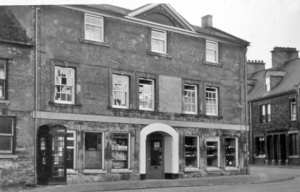
Nos 37 & 38 Market Place, 1950s
Many of the larger houses in Olney were either rebuilt or refaced in the 18th century for lace dealers. The large building on the south-west corner of the Market Place and the main road (Numbers 37 & 38) is an example. It was originally the Catherine Wheel Inn, but was virtually rebuilt and refaced for John Rickards in 1722 and remained a lace dealer’s premises for the next 150 years.
A weekly market has been held on this Market Place since at least 1206 and special bobbins could be obtained at the three fairs held annually on Easter Monday, 29th June (Cherry Fair) and at the Statute Fair in October.
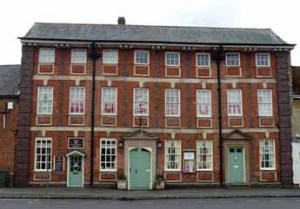
Nos 29 & 30 Market Place, 2012
When the poet, William Cowper, lived at Orchard Side from 1768 to 1786, there were around 1,200 lacemakers in the town and with a population of around 2,500 in those days; consequently half of the inhabitants were lacemakers. The poet was sympathetic to the lacemakers and their hardworking life of long hours and sought, with the Revd. John Newton, to relieve (through the charity of a generous London benefactor), any distress with practical gifts particularly during the winter months. Cowper also signed a petition on their behalf, which went before Parliament when the lacemakers were threatened with a tax which would have ruined their livelihood. Cowper’s own home (Number 30) was later used as a Lace School in the mid 1800s.
Moving on, cross the main road by the zebra crossing and turn right. Pass by the entrance of the Baptist Church , where many of the lacemakers worshipped. Take care as you cross over Spring Lane and walk a short distance down the High Street. Stop at Evelyn House, next to Olney House (Number 15), to look across the street at the Old Penny House (Number 22) to the left of the archway, and the Honey House, the next property (Number 24) to the north.
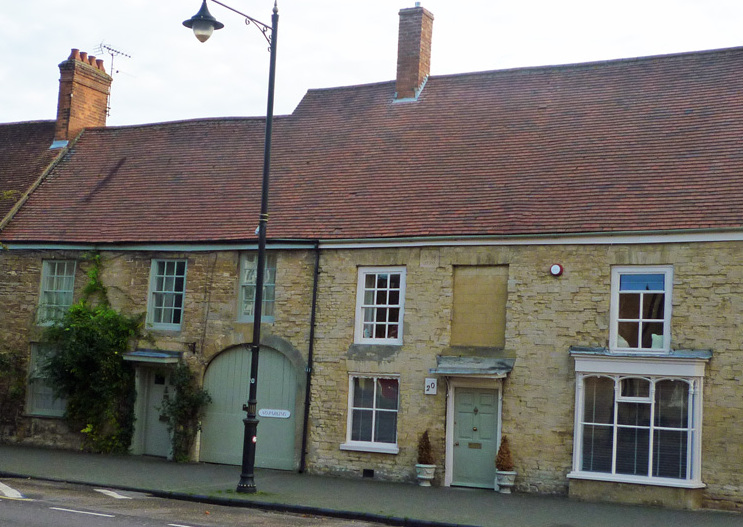
Nos 22 & 20 High Street, 2014
The Old Penny House was a school for girls run by Sarah Duxbury in the 1850s, who also taught them lacemaking, for a few pence a week. Teachers in lace schools were also supposed to teach the girls to read and write, but usually most of the effort was put into lacemaking, as writing would have taken their hands off their lace pillows! The children would be gathered in a room usually with no heating, other than ‘dicky pots’ at their feet, as smoke and dust from a fire would soil their lace. Their necks and arms were kept bare so the teacher could slap them if the lace was worked incorrectly. The extreme punishment for bad work was to have their head thrust forward onto the pillow and their nose rubbed on the pin heads!
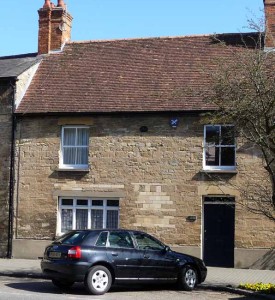
No 24 High Street, 2014
Next door, The Old Honey House is so called because the Cobb family, who lived there in late Victorian times were bee-keepers as well as carpenters and had a licence to make a mead-like drink called Metheglin on St. Andrew’s Day, which was the lacemakers’ holiday on 30th November. This was corrupted to ‘Tanders’ Day. As well as the drink, yeast cakes flavoured with caraway seeds, were eaten and games played like ‘Jack be nimble, Jack be quick, Jack jump over the candlestick’. Following this holiday the lacemakers were allowed to light the candle on the stool surrounded by glass globes for reflection of light in order for them to see to make lace during the dark winter months. (St. Catherine’s Day on 25th November was also a holiday.)
Moving on, walk down to the uncontrolled crossing opposite the United Reformed Church. Look across at the house between the Church and the Hairdresser’s Salon.
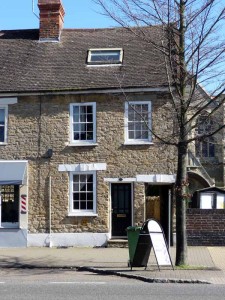
No 44 High Street, 2014
This is Number 44 and was the home of John Millward, a famous lace designer who specialised in designs for the crowns of babies’ caps during the first quarter of the 1800s. Around this time the local lacemakers were feeling the effects of the competition from the machine made lace in Nottingham. However, at first, the machines couldn’t copy anything with a round shape such as babies’ caps. So lots of these babies’ caps were hand made and many exported to America. John Millward also gave evidence to Parliament of the piracy of lace pattern designs. He was still winning awards for his designs at the time of the Great Exhibition in 1851.
The image of John Millward, shown on the left, shows him as a tall gentleman, wearing a high ‘stove-pipe’ hat, and the cut-away tailed coat of the day. He had some sort of foot disability and was nicknamed ‘Dabfoot’ in the town!
The entry alongside his house, which goes through to East Street, is still known as ‘Mill’ards Entry’. Over the years Olneyites have dropped the ‘w’ in ‘Millward’.
Walk a little further down the street, just beyond the Butcher’s shop, to be opposite ‘The Lace Factory’ on the other side of the street.
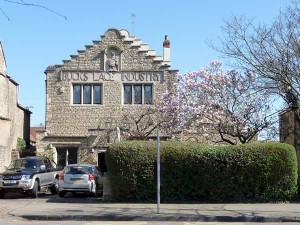
Nos 50 – 56 high Street, 2014
The last great character in the lacemaking world of Olney and district was Harry Armstrong who came to Olney in 1909 from nearby Stoke Goldington , where he had set up the Bucks Cottage Workers Agency in an attempt to revive lacemaking in the area. He was successful and transferred his business to a building near Olney’s former Railway Station in Midland Road for the better communications available nationwide. Again his business thrived and by the 1920s he was looking for larger premises.
The site in the High Street (opposite) was vacant as the buildings had been destroyed by fire in 1924, so Harry employed local builder George Knight to erect in 1928 The Lace Factory, as it became known . Harry wanted a building ‘the like of which Olney has not seen before’ and George had to talk him out of Corinthian columns and other fanciful designs. Being the time of the Great Depression, it was made mostly with second hand materials. The only new work was the carving on the façade, which originally included three huge carvings over the front door of a bobbin winder, candle-stool and a bobbin stand. As these were completely unsupported over the door of the flat-roof front extension they were soon taken down for safety reasons and given to one of Harry’s lady friends. They were rediscovered in her former garden some thirty years ago and the Cowper and Newton Museum acquired them and put them up in the courtyard, where they are to be seen today.
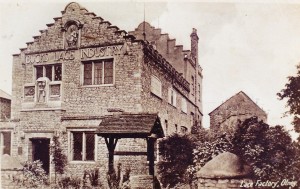
The Lace Factory soon after the large Lace Carvings of a Bobbin Winder, Candle Light and Bobbin Stand were erected above the front door
For a larger size click the image
Lace was never made in the Lace Factory. It was used as offices and as a warehouse, where lace was sewn onto garments or any article that Harry thought could be adorned with lace! It was then packed up into parcels which were sent out worldwide. The lace was still made by women in their homes and brought into the Lace Factory for sale or collected by agents in local villages. Out of their earnings the lacemakers had to buy the thread for the next week’s work!
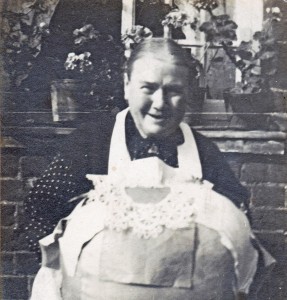
An Olney Lacemaker c.1920s
Mrs Mary Wooding who lived in Osborn’s Court
For a larger size click the image
Harry advertised his business in women’s magazines and by sending out postcards touting for business from individual women or women’s groups. A response would result in the dispatch of a parcel of lace ‘on appro’ (approval). Prospective purchasers were given a month to pay up or return the goods. The late Cis Elderton who worked in the office for him said they lost very few parcels. People were honest in those days!
See Cis talking about the prices paid by Harry Armstrong per yard of lace.
Harry was quite a character as he traded as ‘Mrs Armstrong’, believing women were more likely to buy lace from another woman! Sadly, he died at the early age of 56 while on a business trip to Scotland in 1943.
An example of a pattern together with the finished lace item produced in Olney
Thereafter lacemaking in Olney, as a business, was only carried on by a few older women who made lace for gifts.
Lacemaking enjoyed a revival in Olney in the 1970s, following a national resurgence of the craft in the 1950s and 60s through the efforts of the Women’s Institute and local adult education classes, when the once traditional cottage industry became a leisure time craft. The ‘Olney Lace Circle’ was formed in the 1970s and continues lacemaking today, still as a leisure time activity.
Turn around and, with care, cross the road using the uncontrolled crossing. Walk back towards the Market Place having a closer look at the Honey House and the Old Penny House on the way. Glance down the entrance to Berrill’s Court (next to the Chemist’s shop – No 14 Market Place) where many of the lacemakers lived in small thatched cottages. Return to the Cowper and Newton Museum to view the many lacemaking artefacts it contains along with an excellent collection of local lace.
We hope you have enjoyed your visit to Olney and will make a return excursion soon.
Elizabeth Knight, October 2015
.
Copyright © 2015 Elizabeth Knight
.

